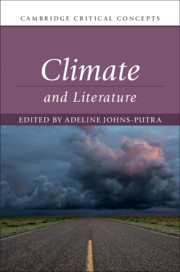Book contents
- Climate and Literature
- Cambridge Critical Concepts
- Climate and Literature
- Copyright page
- Contents
- Illustrations
- Contributors
- Acknowledgements
- Introduction
- Part I Origins
- Part II Evolution
- Chapter 7 Weather and Climate in the Age of Enlightenment
- Chapter 8 British Romanticism and the Global Climate
- Chapter 9 The Literary Politics of Transatlantic Climates
- Chapter 10 Climate and Race in the Age of Empire
- Chapter 11 Ethereal Women: Climate and Gender from Realism to the Modernist Novel
- Chapter 12 Planetary Climates: Terraforming in Science Fiction
- Chapter 13 The Mountains and Death: Revelations of Climate and Land in Nordic Noir
- Part III Application
- Bibliography
- Index
Chapter 8 - British Romanticism and the Global Climate
from Part II - Evolution
Published online by Cambridge University Press: 31 July 2019
- Climate and Literature
- Cambridge Critical Concepts
- Climate and Literature
- Copyright page
- Contents
- Illustrations
- Contributors
- Acknowledgements
- Introduction
- Part I Origins
- Part II Evolution
- Chapter 7 Weather and Climate in the Age of Enlightenment
- Chapter 8 British Romanticism and the Global Climate
- Chapter 9 The Literary Politics of Transatlantic Climates
- Chapter 10 Climate and Race in the Age of Empire
- Chapter 11 Ethereal Women: Climate and Gender from Realism to the Modernist Novel
- Chapter 12 Planetary Climates: Terraforming in Science Fiction
- Chapter 13 The Mountains and Death: Revelations of Climate and Land in Nordic Noir
- Part III Application
- Bibliography
- Index
Summary
As a result of developments in the meteorological and geological sciences, the Romantic period saw the gradual emergence of attempts to understand the climate as a dynamic global system that could potentially be affected by human activity. This chapter examines textual responses to climate disruption cause by the Laki eruption of 1783 and the Tambora eruption of 1815. During the Laki haze, writers such as Horace Walpole, Gilbert White, and William Cowper found in Milton a powerful way of understanding the entanglements of culture and climate at a time of national and global crisis. Apocalyptic discourse continued to resonate during the Tambora crisis, as is evident in eyewitness accounts of the eruption, in the utopian predictions of John Barrow and Eleanor Anne Porden, and in the grim speculations of Byron’s ‘Darkness’. Romantic writing offers a powerful analogue for thinking about climate change in the Anthropocene.
Keywords
- Type
- Chapter
- Information
- Climate and Literature , pp. 128 - 143Publisher: Cambridge University PressPrint publication year: 2019
- 1
- Cited by

